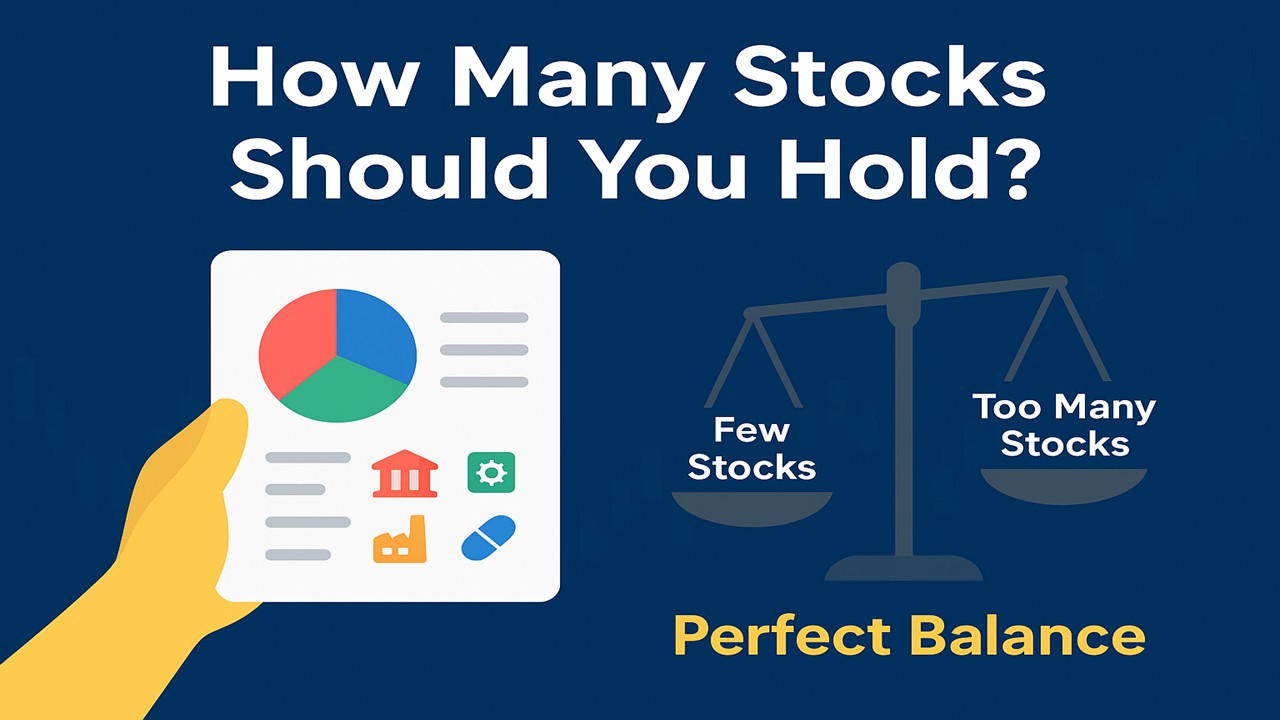
When you step into the stock market, you quickly face a tricky question:
“How many stocks should I actually hold?”
If you hold too few, one bad stock can sink your portfolio.
If you hold too many, your returns get watered down.
So, what’s the sweet spot? Let’s break it down with clarity, examples, and a bit of common-sense investing wisdom.
1. Too Few Stocks – Walking on a Tightrope
Owning just 2-3 stocks is like riding a bike without brakes – one wrong turn and you crash.
Imagine you invest only in one bank and one IT company. If the banking sector hits a crisis, half of your investment could vanish overnight.
Key Problem: Your risk is concentrated in too few companies.
Golden Rule: Never let one stock or sector hold the fate of your entire portfolio.
2. Too Many Stocks – The “Soup with Too Much Water” Problem
A portfolio with 30-40 stocks sounds safe, but it’s like adding so much water to soup that you can’t taste the ingredients.
- Tracking performance becomes exhausting.
- Strong performers get lost among weaker ones.
Key Problem: Returns get diluted, and you lose focus on your winners.
3. The Sweet Spot – The Golden Range
Most market experts agree:
- For long-term investors: 12 to 18 well-chosen stocks
- For short-term traders: 6 to 10 stocks
This range gives enough diversification to manage risk but not so many that you lose control.
4. Sector Diversification – Don’t Put All Your Eggs in One Basket
Even with the right number of stocks, if they’re all in the same sector, your portfolio is in danger.
Example:
If 80% of your investments are in the auto sector and a slowdown hits, your portfolio could take a serious hit.
Smart Approach:
- Limit any single sector to 20-25% of your total portfolio.
- Spread across sectors like Banking, IT, FMCG, Pharma, Auto, and Infrastructure.
5. Market-Cap Mix – Balancing Safety and Growth
A healthy portfolio blends stability with growth potential:
- Large Cap (Safe, stable) → 50%
- Mid Cap (Moderate risk, high growth) → 30%
- Small Cap (High risk, high reward) → 20%
Sample Structure:
| Category | No. of Companies | Example Sectors |
| Large Cap | 6-8 | Banking, FMCG |
| Mid Cap | 4-5 | Auto, IT |
| Small Cap | 2-3 | Pharma, Chemical |
6. Regular Portfolio Checkups – Like a Health Report
The market is constantly changing. Today’s star stock could be tomorrow’s laggard.
- Review your portfolio every 3-6 months.
- Cut out underperformers and replace them with better opportunities.
7. Real-Life Example – Rahul’s Balanced Portfolio
Rahul holds 15 stocks:
- 4 Large Cap: HDFC Bank, Infosys, Hindustan Unilever, Reliance
- 6 Mid Cap: Tata Power, Mphasis, Minda Industries, Jubilant Foodworks, APL Apollo, Deepak Nitrite
- 5 Small Cap: KEI Industries, IEX, Laurus Labs, Neogen Chemicals, Gokaldas Exports
Why it works:
- Large Caps = Stability
- Mid Caps = Growth potential
- Small Caps = Faster returns
And no single sector exceeds 25% exposure.
Final Takeaway
When deciding how many stocks to hold:
- Too few → High risk
- Too many → Weak returns
- Balanced range → 12-18 stocks for most long-term investors
But remember: Diversification is about quality, sectors, and market caps – not just numbers.




































































